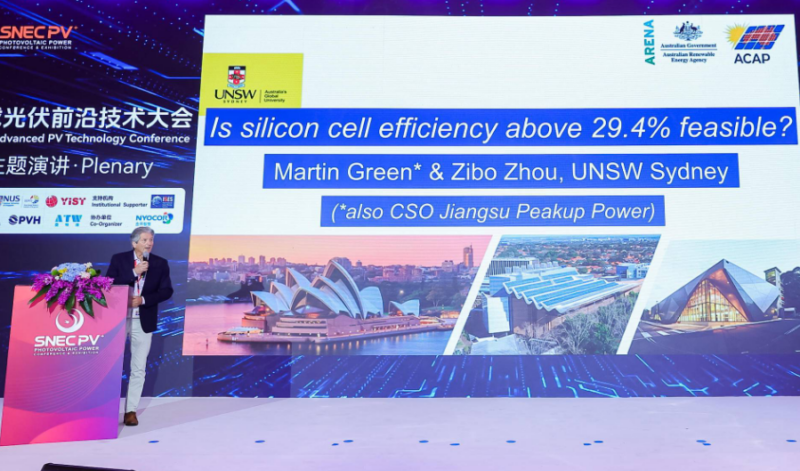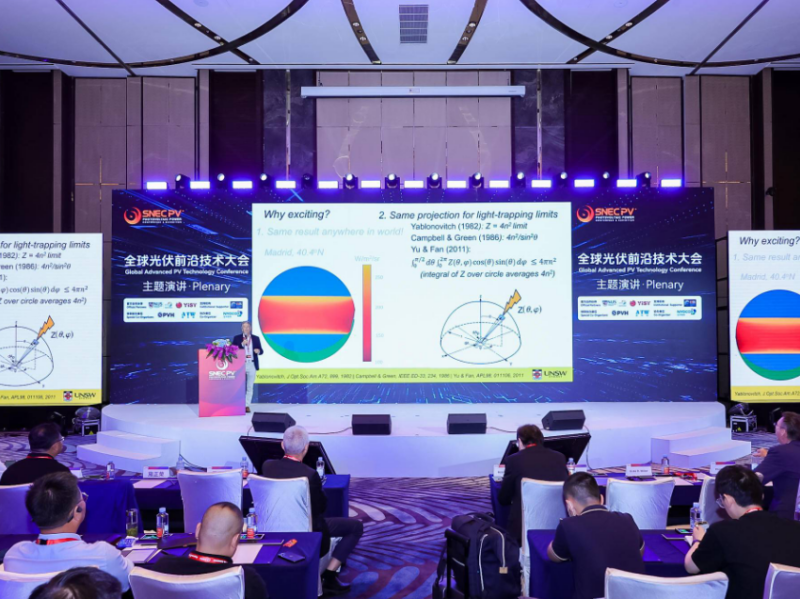PVTIME – On 12 June 2024, Professor Martin Green, known as the father of modern photovoltaics, gave a speech at the opening ceremony of SNEC 2024, the world’s largest PV solar event in Shanghai, China, on whether silicon cell efficiency above 29.4% is feasible.

Last year at SNEC in Shanghai, Professor Martin Green discussed how far solar cell manufacturers can push the efficiency of silicon cells, which is of interest to all major players in the industry. The limit efficiency of a silicon solar cell operating at one sun was well calculated by Professor Martin in 1984 at around 29%, and with concentrated work on solar cell technology, Professor Martin has calculated a possible maximum efficiency for p-type cells in 2022 at 29.4%.
This year, Professor Martin Green gave a very clear answer that the theoretical limit of 29.4% can be exceeded, after explaining how the limits came from 18%, 20.3% to 21.9% since the 1950s.
By constantly looking in all directions, including the angle of incidence, Professor Martin stated that there is still room for improvement between 29% and 30% if the angle of incidence of the panels is taken into account. In fact, the theoretical limit of 29.4% has been raised to 29.56%, so 29.4% is a lower limit rather than an upper limit of efficiency.
How can the conversion efficiency be improved? This mainly depends on the intensity of the solar radiation and the angle of the radiation. After very complex calculations, taking into account the energy density of direct radiation and the angle of inclination, the limit of 29.4% can be increased to 29.7%.

The conversion efficiency can be further increased by improved light trapping methods on the solar cells, including well-designed solar cells with AR coating, 2D grating design and cross slot.
Meanwhile, single or dual axis tracker systems can significantly increase the sunlight capture rate on the solar panels. Trackers can have different angle slats and different structure. The angle of the slats is a very important factor. A well designed tracker can perform very well with a large amount of sunlight capture, consequently getting more annual energy with the whole system.
Carefully designed solar cells plus a tracker system with one or two axis rotation to capture as much sunlight as possible, together with an optimally designed cross slot (thickness less than 100 microns, possibly 60 microns), can make the conversion efficiency even more than 30%!
Seasonality and local conditions should also be taken into account. Today, most common designs do not take into account light tracking, light trapping, light incidence, so there will not be a big increase in the conversion efficiency of the solar system. It should not be too much of a problem to optimise the design with some tailor-made technologies according to the local conditions to increase the conversion efficiency by 1%.

Scan the QR code to follow PVTIME official account on Wechat for latest news on PV+ES










